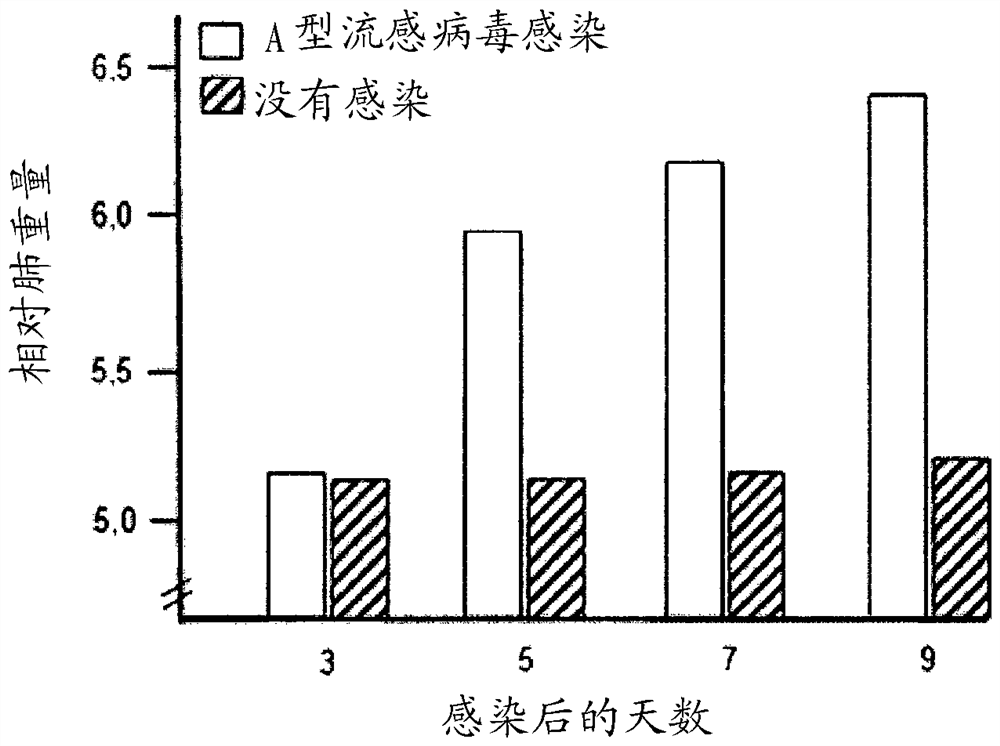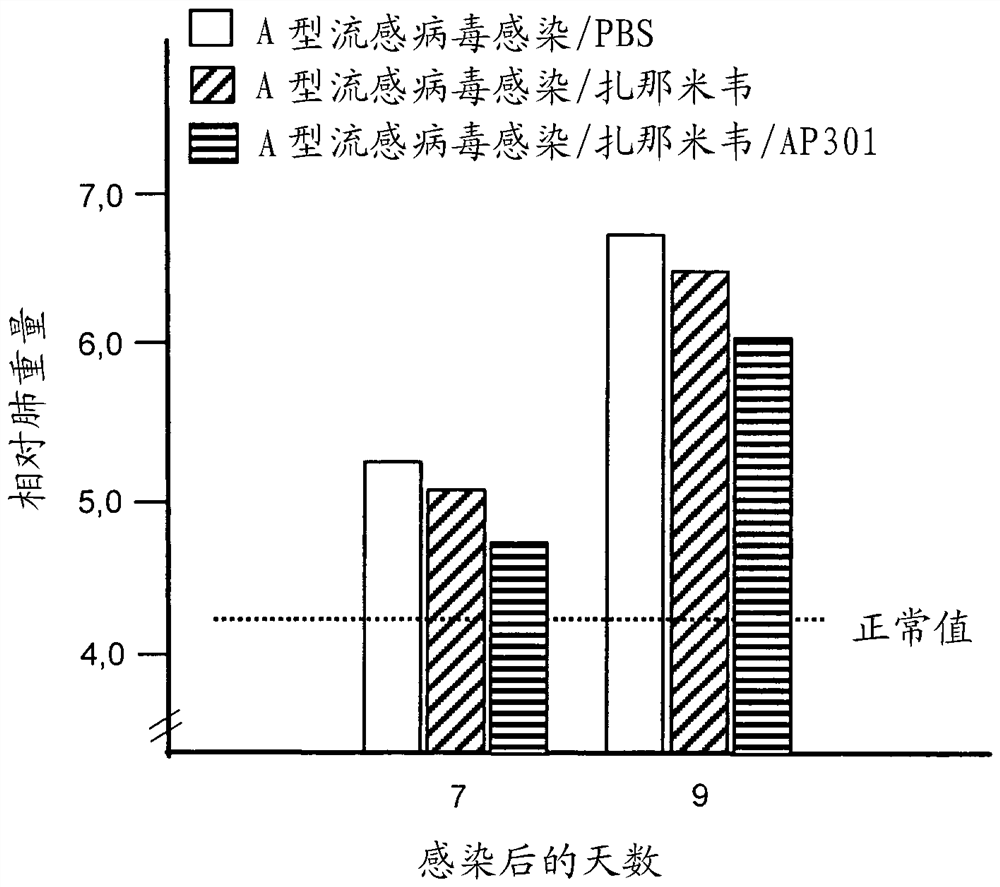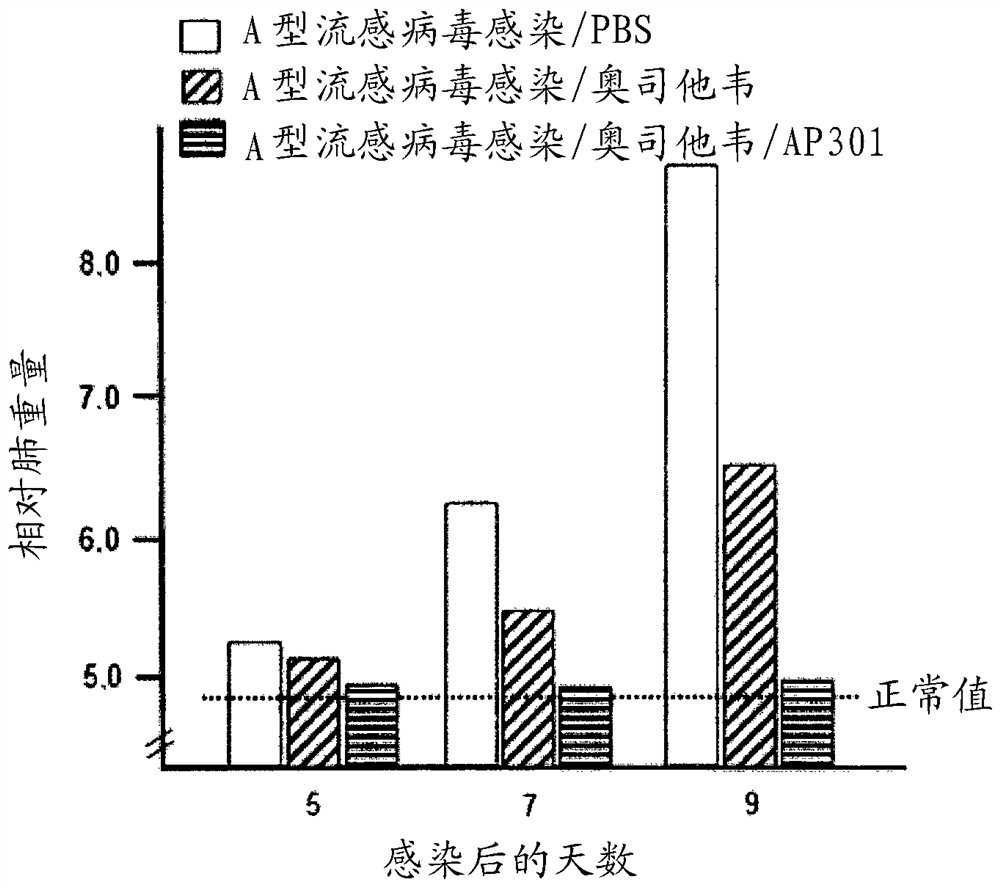Composition comprising a peptide and an inhibitor of viral neuraminidase
A neuraminidase and composition technology, which can be used in antiviral agents, drug combinations, medical preparations containing active ingredients, etc., and can solve problems such as high variability of influenza virus
- Summary
- Abstract
- Description
- Claims
- Application Information
AI Technical Summary
Problems solved by technology
Method used
Image
Examples
Embodiment 1
[0066] Influenza virus infection can cause the development of pneumonia
[0067] Laboratory mice (C57BL / 6 strain, 8 weeks old) were infected nasally with an influenza A strain (PR8 / 34) and a dose of 150 PFU. On days 3, 5, 7, and 9 post-infection, lungs were removed from 8 mice each, and relative lung weights were determined as a measure of pneumonia.
[0068] Examination showed that the weight of the lungs increased more compared to the control lungs as the duration of the mice's infection with the influenza virus increased. The results are shown in figure 1 middle.
Embodiment 2
[0070] Treatment of pneumonia by administration of a neuraminidase inhibitor or a combination of a neuraminidase inhibitor and peptide AP301
[0071] Laboratory mice (C57BL / 6 strain, 8 weeks old) were infected nasally with an influenza A strain (PR8 / 34) and a dose of 150 PFU. Subsequently, the test animals received oral administration of 10 mg / kg oseltamivir (neuraminidase inhibitor) and intratracheal administration of 10 µg peptide AP301 / test animal, respectively. On test days 2 and 4, the treatment was repeated.
[0072] On days 5, 7, and 9 post-infection, lungs were removed from 30 mice each, and relative lung weights were determined as a measure of pneumonia. The results are shown in figure 2 middle.
[0073] Examinations indicated that neuraminidase inhibitors produced only a moderate reduction in pneumonia as measured by lung weight. However, if the peptide AP301 was administered to influenza virus-infected mice in addition to the neuraminidase inhibitor, pneumonia ...
Embodiment 3
[0075] The pro-inflammatory properties of the AP301 peptide were assessed ex vivo in human whole blood
[0076] An ex vivo-in vitro-safety pharmacology study of the AP301 peptide was performed in human whole blood to determine whether the AP301 peptide resulted in the release of the pro-inflammatory marker interleukin-6 (IL-6) (i.e. APN 301 Will exhibit TNF-specific inflammatory activity (ie TNF-receptor-binding activity)). In this study, fresh whole blood, which is a recognized predictive model for assessing inflammatory responses in vivo, has been used.
[0077] Method summary
[0078] The goal of this study was to determine the pro-inflammatory signaling capacity of the AP301 peptide. Whole blood cultures were used here and the secretion of interleukin-6 (IL-6), a very sensitive marker of proinflammatory stimuli, was quantified by means of ELISA.
[0079] test system
[0080] test system 25 ml of freshly collected heparinized blood from 5 healthy subjects (GP) were u...
PUM
| Property | Measurement | Unit |
|---|---|---|
| volume | aaaaa | aaaaa |
Abstract
Description
Claims
Application Information
 Login to View More
Login to View More - R&D
- Intellectual Property
- Life Sciences
- Materials
- Tech Scout
- Unparalleled Data Quality
- Higher Quality Content
- 60% Fewer Hallucinations
Browse by: Latest US Patents, China's latest patents, Technical Efficacy Thesaurus, Application Domain, Technology Topic, Popular Technical Reports.
© 2025 PatSnap. All rights reserved.Legal|Privacy policy|Modern Slavery Act Transparency Statement|Sitemap|About US| Contact US: help@patsnap.com



